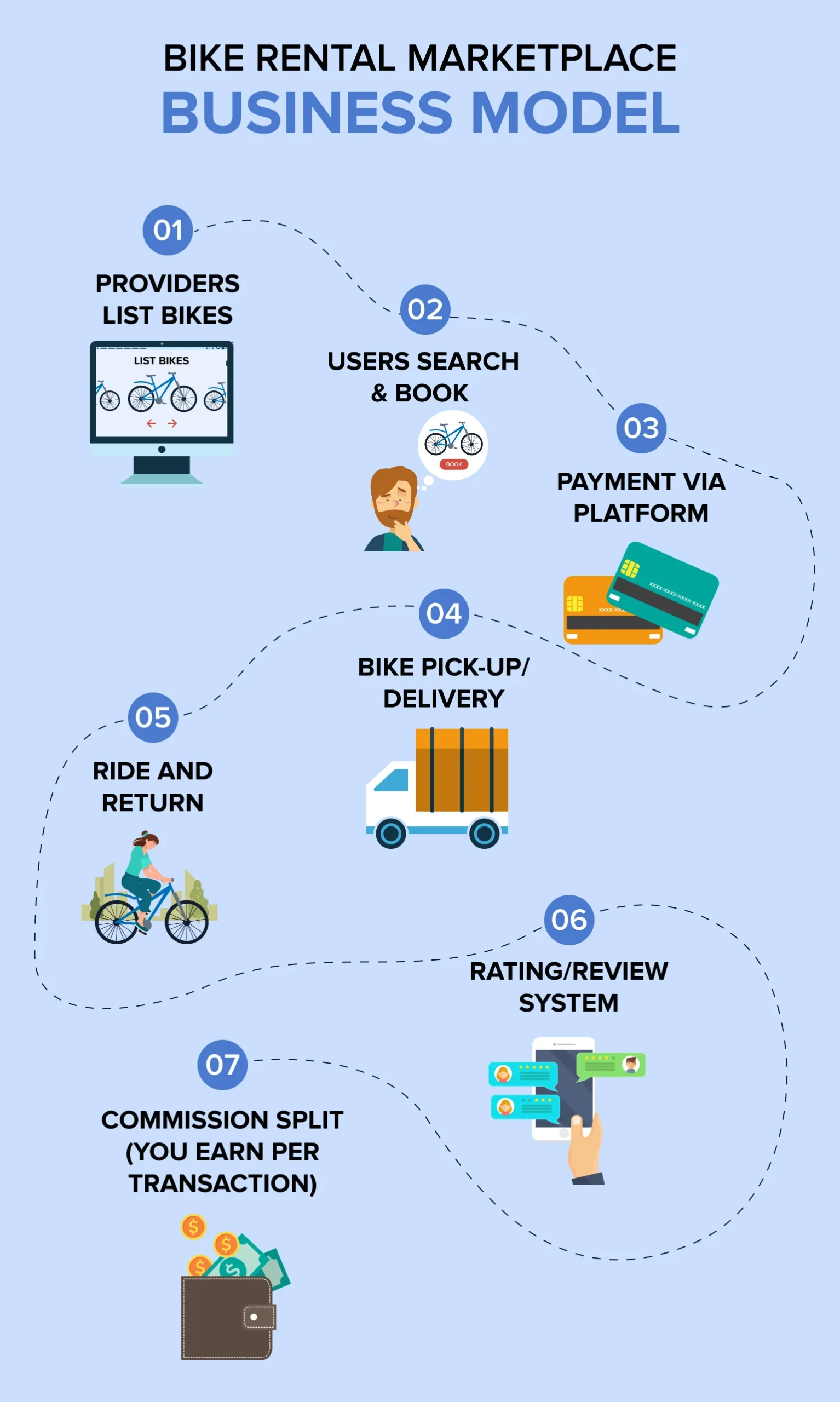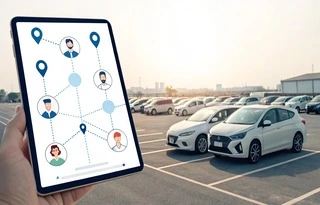Subscribe and you will promptly receive new published articles from the blog by mail
The global bike rental market is shifting into high gear. Valued at $2.1 billion in 2021, the industry is racing toward an impressive $11.3 billion by 2031, boasting a CAGR of 18.5% from 2022 to 2031.
Why the surge? Urban congestion, climate change awareness, the rise of eco-tourism, and the micromobility revolution have all fueled demand for flexible, sustainable transportation. For entrepreneurs researching how to start a bicycle rental business, early-stage founders exploring a bike rental start-up, and even municipalities, this translates into a golden opportunity: launching a bike rental marketplace that connects bike owners with riders — on-demand, on-location, and on-brand.
At Roobykon Software, we’ve helped marketplace founders turn brilliant ideas into scalable digital platforms. In this guide, we’ll walk you through everything you need to know about starting a bicycle rental business, from choosing the right business model to defining features, tech stack, and monetization strategies. Shall we begin?
Explaining the bike rental business model
A bike-rental website operates as a two-sided platform connecting bike providers (rental shops, private owners, or fleet operators) with end-users (travelers, commuters, students, etc.) looking to rent bikes for a few hours, a day, or even a week.
There are three common variations of the bike-rental business model:
P2P (peer-to-peer) rentals
Like Airbnb for bikes, this bicycle rental business model lets individual bike owners rent out their bikes to verified users through your platform. You act as a facilitator, handling bookings, payments, and often insurance.
Example: Spinlister (now defunct but conceptually inspiring).
B2C (business-to-customer) rentals
Bike rental companies or small local shops list their fleets on your platform. You streamline discovery, scheduling, and payment while allowing providers to focus on logistics.
Example: Donkey Republic or Lime.
Hybrid model
A mix of P2P and B2C, offering flexibility and better coverage. In this city bike rental business, users can choose between bikes owned by individuals or rental stations based on convenience and pricing.
If you’re interested in exploring how similar principles apply beyond bikes, check out our breakdown of the car-sharing business model to see how it scales and diversifies.

Examples of successful bike rental platforms
To better understand how to start a bike rental business, it’s worth looking closely at a few bike rental sites that have already carved out strong positions in the market. These companies built ecosystems around micromobility, convenience, and user trust—elements anyone opening a bike rental business should consider.
Take Donkey Republic, for example. This Copenhagen-born startup began with a vision of making urban biking effortless through a dockless rental system, where riders unlock bikes with their phones and leave them anywhere within a city’s designated zones. The company emphasized seamless hardware-software integration by using smart locks that sync with its app – essential insight if you’re asking yourself how you would design a bike rental service – cutting out the need for keys, paperwork, or even staff at rental stations. Today, the platform attracts around 165,000 visitors each month, with Denmark leading as its most active market, proving just how strongly the concept resonates in its home country and beyond.


Meanwhile, Lime has taken a broader micromobility approach, offering not just bikes but also e-bikes and scooters in hundreds of cities worldwide. What sets Lime apart is its razor-sharp focus on accessibility and data. The platform provides cities with rich mobility data that helps inform infrastructure decisions and traffic planning, making it a case study in building the best bike rental app with value for both users and municipalities. In terms of popularity, Lime attracts around 1.132 million visitors per month, with the United States being the top market. The platform’s traffic is driven largely by organic search and direct conversions, which underlines both strong brand recognition and user demand. (Source: Similarweb)



Then there’s Nextbike, a German-based e-bike rental business that has become a major player in Europe’s public bike-sharing schemes. Rather than competing with city transport authorities, Nextbike collaborates with them, offering fully integrated fleet systems managed via public-private partnerships. It’s a brilliant example of platform thinking: rather than owning all assets directly, Nextbike licenses out its technology, enabling other cities to run their own branded bike-sharing programs powered by Nextbike’s infrastructure. The platform attracts around 150,700 visitors per month, with Germany being its largest user base — a clear indicator of how deeply embedded Nextbike has become in its home market while continuing to expand across Europe.


And we can’t ignore Spinlister, one of the early peer-to-peer pioneers in the electric bike rental business scene. Though it no longer operates under its original model, Spinlister’s early traction proved that the sharing economy model could work for high-value, niche assets like bikes. It also laid the groundwork for trust-based rentals, with strong emphasis on user reviews, damage protection, and transparent communication between parties.
All of these platforms approached the market differently, but they share one thing in common: they solved a real problem with a clear, frictionless user experience.
How to start a bike rental marketplace
Starting a bike rental business is clearly a strategic launch into an evolving mobility ecosystem. To do it right, you need to approach the process with a product mindset, an entrepreneurial eye, and a strong grip on the tech stack powering your business.
Choose the right software platform for your future bike rental business
Your platform is the engine under the hood. Choose the wrong one, and your marketplace might stall before it even gains traction. Let’s compare the three main types of bike-rental business software approaches:

At Roobykon, we often recommend starting with a Sharetribe bike platform or a custom MVP using Ruby on Rails, giving you the best of both speed and extensibility. As a Sharetribe partner, we can help you launch quickly, and if you need to scale or add custom features, you can hire RoR developers from our team to take your platform to the next level.
We’ve also helped launch several successful car-sharing marketplaces, demonstrating how flexible and powerful the platform can be.
Analyze competitors and identify key features for renters and bike owners
You can’t set up a bicycle rental business in a vacuum. Competitive analysis is your shortcut to product-market fit. Look at players like Donkey Republic, Lime, Spinlister, or Nextbike and dissect:
- What features are non-negotiable?
- Where do they drop the ball on UX?
- What monetization gaps can you fill?
Must-have features for renters:
- Real-time availability calendar
- Smart search by location & bike type
- Live GPS map & bike pickup points
- Secure checkout (Stripe, PayPal, Apple Pay)
- Insurance coverage and safety add-ons
- Multi-language support
- Ride history and repeat booking
Must-have features for bike owners/providers:
- Easy bike listing process
- Dynamic pricing tools
- Calendar sync & availability controls
- Push/email booking notifications
- Analytics dashboard (earnings, views, bookings)
- Built-in insurance or damage claims module
Many principles from bike rentals apply to car sharing, but with added emphasis on vehicle management, driver verification, and fleet optimization. Must-have features include: seamless identity verification, intelligent vehicle search and booking, payout rescheduling (for admins), etc.
Launch strategy for your bicycle rental website + roadmap
Phase 1: Discovery & validation (1–2 months)
- Market research & competitor mapping
- Define business model and key differentiators
- Choose your platform (No-code, headless, or custom)
- Build wireframes & mockups
Phase 2: MVP development (2–4 months)
- Core features: Search, booking, payments, calendar
- Responsive frontend & admin panel
- Integrate third-party tools: Stripe, Mapbox, SendGrid, etc
- Launch in a single city or market
Phase 3: Go-to-market strategy (1–2 months)
- Local SEO and paid ads targeting key locations
- Partnerships with local bike shops or tourist boards
- Promo codes & referral campaigns
- Social proof via early testimonials
Phase 4: Iteration & growth (ongoing)
- Gather user feedback
- Optimize UX/UI and booking flows
- Add premium features (subscriptions, insurance, smart lock integration)
⏱ Total launch timeline: ~4 to 6 months
📈 Break-even point: Typically 6–12 months post-launch, depending on your overhead and adoption.
Scaling the bike/bicycle marketplace experience
Success breeds complexity, and scaling your platform means preparing for that. As your user base grows and your operational footprint expands, your system must evolve to support multiple geographies, currencies, and logistics workflows. For example, in bike rental app development, this may involve multi-branch configurations, localized interfaces, or advanced booking algorithms that manage peak demand intelligently.
Analytics becomes essential at this stage, not just basic dashboards, but actionable data about user behavior, supply utilization, and lifecycle churn. Security, too, must level up, introducing ID verification, platform-wide encryption, fraud detection, and a robust support infrastructure.
More importantly, your team will need to shift from a reactive mode to a proactive growth machine. That means iterating fast, managing technical debt, and making product decisions based on real-time metrics, not gut feelings. And if you’re planning how to launch a bike rental service, building scalability into the foundation ensures you won’t hit growth bottlenecks later.
Evolving the bike platform: maintenance and continuous improvement
Once your marketplace is live and operating, the real work begins. A bicycle platform, like any digital product, is a living organism. It requires regular updates, performance optimization, UX refinement, and constant listening to your community.
Don’t underestimate the value of post-launch rituals in running a bike rental business – weekly monitoring, quarterly audits, and biannual UX reviews. Keep a backlog of feature requests and rank them based on business value and user impact. Stay ahead of competitors not by chasing trends, but by deeply understanding what your users are telling you, even if they’re not saying it out loud.
Support should mature along with the product. What started as an email inbox may evolve into live chat, ticketing systems, or even AI-powered assistants – and here’s how to use AI in your marketplace launch to boost efficiency from day one. Documentation, FAQs, and onboarding tutorials – all of these touchpoints shape the user experience just as much as your codebase.
Finally, don’t let growth blind you to pitfalls. Even experienced founders can fall into traps, so check these mistakes before you scale further.
Our bike rental case studies
Sometimes the best ideas are born out of everyday frustration. That’s exactly how Swoop came to life. Three friends, Tadas, Jevgenijus, and Vytautas, were tired of scrolling through messy social media groups and scattered online stores just to find a decent bike part. It was time-consuming, unreliable, and anything but user-friendly.
So, they decided to change that. Their idea was simple: build a Sharetribe bicycle platform that made buying and selling sports gear easy, safe, and enjoyable. Not just for cyclists like themselves, but for anyone passionate about sports. And that’s where we at Roobykon Software came in, to help them bring that vision to life.
Swoop is a place where people across Lithuania can find quality used sports equipment without the hassle. It promotes sustainability by giving great gear a second life and helps make sports more accessible by keeping prices fair.
Challenges we faced together
Like with many startups, the biggest challenge was balancing ambition with budget. The founders had big plans and a clear idea of what the platform should look and feel like, but we had to be smart about prioritizing features without losing sight of the end goal.
Together, we worked through scope planning, phased feature rollouts, and continuous feedback loops. It wasn’t always easy, but open communication and shared focus made it possible to stay on track, on budget, and in sync.
If you’re starting a bike rental company, this kind of strategic prioritization is critical — and it ties directly into why the marketplace business model works so well.
A quick look at the stack
- Platform: Sharetribe Flex (API-based)
- Frontend & backend: JavaScript, Node.js, Redux, Express
- Geolocation: Mapbox for interactive maps and local search
The result: a platform that feels like home for sports lovers
Swoop is now one of Lithuania’s most promising platforms for used sports gear, and it’s just getting started. What began as a passion project among friends has grown into a thriving digital space where sports enthusiasts can connect, trade, and support sustainable practices.
Roobykon: your future technology partner
If you’ve made it this far, chances are you’re seriously considering starting a bike rental company — or maybe you’re already knee-deep in the process and looking for the right tech partner to bring it all together.
That’s where Roobykon comes in.
We’re not just a team of developers who build what you ask for. We’re collaborators, strategists, problem-solvers — the kind of partner who treats your business like our own. Whether you’re just sketching ideas on a whiteboard and wondering how to create a bike rental app or already managing a growing platform, we plug in wherever you need us most.
Our sweet spot? Complex, feature-rich marketplaces that need to scale — fast. We’ve worked with founders who started with zero tech background, as well as teams who needed to pivot quickly. If you’re exploring how to run a bicycle rental business, our experience — combined with a deep understanding of rental industry trends — means we can help you anticipate changes, avoid costly missteps, and build something sustainable.
We’ve built on everything from Sharetribe Flex to custom headless stacks, and we’re always thinking beyond the tech: What’s the best experience for your users? How will you scale without performance headaches? What features make sense now, and what can wait?
So, if you’re looking for a partner to help you build something that actually works (and lasts), we’re ready when you are.
Recommended articles
 How to Build a Car-Sharing Website Like Turo: Complete Guide for 2025
How to Build a Car-Sharing Website Like Turo: Complete Guide for 2025Thinking about launching a peer-to-peer car sharing platform like Turo? This complete 2025 guide walks you through everything from business models and key features to insurance, tech stack choices, and growth tactics.
 How to Track and Reduce Your Marketplace’s Carbon Footprint
How to Track and Reduce Your Marketplace’s Carbon FootprintOver 1,000 companies are pledging net-zero goals, and digital platforms are next. Discover practical ways to measure and lower your marketplace’s carbon footprint from the codebase to the cloud.
 Understanding the car-sharing business model
Understanding the car-sharing business modelAt Roobykon, we're fascinated by how digital platforms are transforming mobility, making transportation more flexible, sustainable, and community-focused. In this in-depth guide, we unpack the business logic behind the rise of car, boat, and bike sharing.
 Must-have features for launching a trusted vehicle-sharing platform
Must-have features for launching a trusted vehicle-sharing platformTrust is everything in shared mobility. This article unpacks how intuitive UX, transparent pricing, secure payments, and flexible admin tools come together to build user loyalty. Learn from real examples and best practices shaping the future of car sharing.






